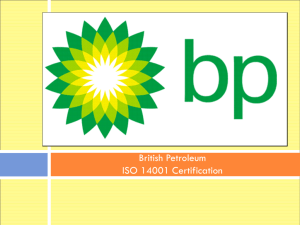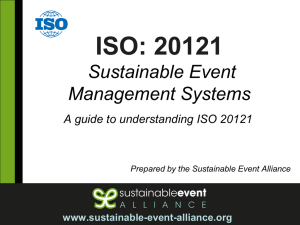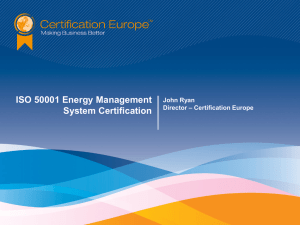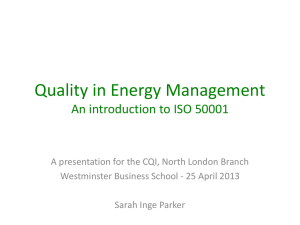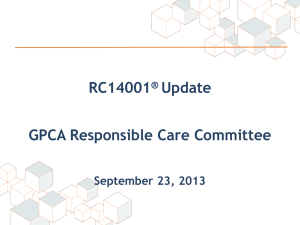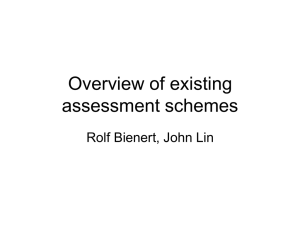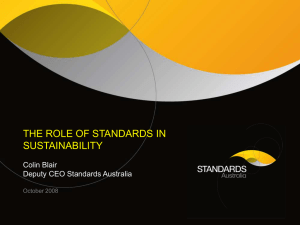green certification
advertisement
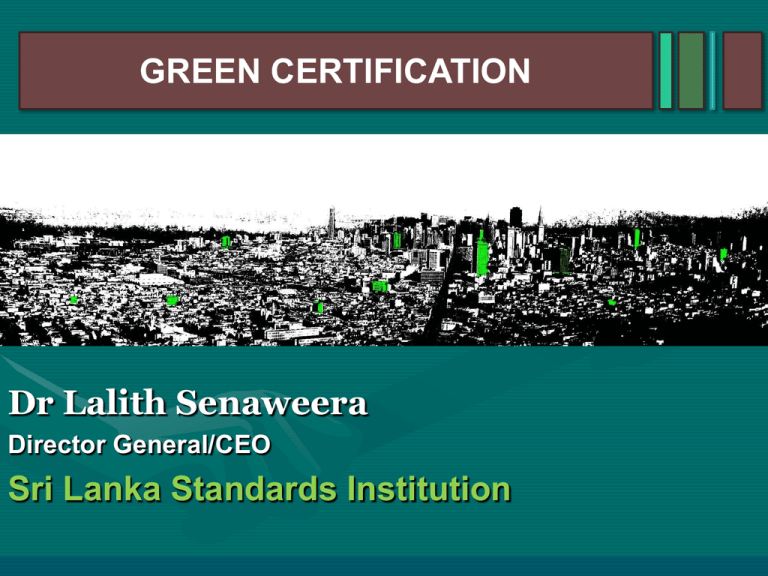
GREEN CERTIFICATION Dr Lalith Senaweera Director General/CEO Sri Lanka Standards Institution WHY GREEN-Global Issues, Local Opportunity • Climate change Natural resource depletion ► Water pollution ► By 2035, 75% of buildings will be new ► Human health or renovated ► Water scarcity ► Ecological degradation ► Energy security Green Building : Why? Development and Water Consumption • Global • 1900-2000: consumption rate doubled that of population • 2025: 2/3 population in “water stressed” conditions Green Building : Why? Development and Natural Resources • Global • Buildings account for 40% of raw material use • C&D waste is 20% of world waste stream • 2.8 pounds / person / day • 1998-2002: Number of landfills dropped by 77% Green Building : Why? Buildings and Energy • Energy • Buildings account for ½ of total energy consumption Green Building : Why? Buildings and Climate Change • Business as usual • 2 C rise by 2050 • 3 C rise by 2100 1’ rise = 100’ in coastal flooding Green Building : Why? Sea-level rise projections : a few inches to a few feet •2 ft: U.S. would lose 10,000 square miles •Affects erosion, loss of wetlands, freshwater supplies •Half of the world’s population lives along coasts •Big question: Ice sheets Development and Wetlands –Global •1900-2000: ½ of wetlands lost •$3.4 billion value Green Building : Why? HUMAN HEALTH ABOUT LIVING INDOOR • Do we know that – – Most of us spend about 90% of our time in indoors – Many building product contain Chemicals commonly known as Volatile Organic Compound (VOC) that emit harmful vapours over time – In a short time these vapours effect health – running nose, tears from the eyes and throat irritation are typical symptoms. – Over time, indoor chemical vapours from building materials may seriously impact reproductive health, increase the risk of cancer and contribute to respiratory illness like asthma – Children and elders are more vulnerable to building material toxicity and indoor air pollution Buildings and Human Health • Indoor Air Quality • Pollutant levels can be 10-100 times outdoors • 2007 Study: 9 out of 10 homes have poor IAQ – particle allergens – chemical pollutant, – CO2 – temperature – humidity – carbon monoxide • Costs • $30 billion/year in health care costs • $100 billion in sick leave and productivity Green Building : Why? Fundamentals • Humans need protection from elements • Human population is growing • Built environment is increasing Green Building : Why Year World Population (billions) 2010 6.8 2020 7.6 2030 8.3 2040 8.9 2050 9.4 Source: US Census Bureau Overview Think Green How can an environmentally conscious business use their community and social concern to create a competitive advantage for themselves while encouraging others to do their part in saving the planet for future generations? Objectives • • • • • • • Enhance your image in the community Improve your reputation with current customers Attract new customers Reduce operational cost Better employee relations Increased free publicity for green products Differentiating your business from your competitors • Demonstrate to the world you are an environmentally aware company What is sustainability • A strategy by which communities seek economic development approaches that also benefit the local environment and quality of life.. Is a process of achieving human development Contributed through effective management of social ,economic and environment benefits Global Drivers of Sustainability • Increasing Industrialization • Proliferation & Interconnection of Civil Stakeholders • Emerging Technology • Effects of Globalization- poverty, inequity, population explosion Triple Bottom Line TBL“ or "3BL", What is TBL • An expanded spectrum of values and criteria for measuring organizational and societal success – economic, environmental, social. • In the private sector, a commitment to CSR implies a commitment to some form of TBL reporting. The Triple Bottom Line is made up of "Social, Economic and Environmental" "People, Planet, Profit " Triple Bottom Line Accounting • Expanding the traditional reporting framework • Take into account environmental and social performance in addition to financial performance. • Company's responsibility to 'stakeholders' rather than shareholders. GLOBAL REPORTING INITIATIVE GRI The Global Reporting Initiative attempts to make the Triple Bottom Line operational VISION The Global Reporting Initiative’s (GRI) vision is that reporting on economic, environmental, and social performance by all organizations becomes as routine and comparable as financial reporting. GRI accomplishes this vision by developing, continually improving, and building capacity around the use of its Sustainability Reporting Framework. Sustainability Categorizing Sustainability Indicators Categories are based on: • TBL • Relationship between the daily practices and sustainability • Strength of this relationship Ex: In the UN CSD, “proportion of urban population living in slums” addresses this relationship directly through poverty, whereas this relationship is also addressed indirectly through health, governance or land. • Characteristics of the building industry TRENDS & CHALLENGES • CHANGING BUSINESS ENVIRONMENT Environmental Concerns • Will CLEAN air & water continue to be available ? • Will food be from polluted source ? • Will flora & fauna continue to exist ? • Will there be more flooding ? • Will there be more new diseases ? • Will the temperature of the environment be rising ? How are WE positioned in this “Storm” ? Can the Human Race do Something ? YES ! THEY CAN Green the Supply Chain • ONE ANSWER TO THIS QUESTION • IS • TO GO FOR GREEN Green Building: How? Background • The drive to “go green” is undoubtedly welcome as the problems of water shortage, energy crisis and climate change are seemingly here to stay. • Also the green concept has to be developed for local context so that they can be still be applied within the local and financial needs. Green Building Green buildings have less negative impact on the environment than standard buildings. Their construction minimizes on-site grading, saves natural resources by using alternative building materials, and recycling construction waste rather than sending truck after truck to landfills. WORLD ACCEPTABLE STANDARDS • • • • • • LEED CERTIFICATION - USA BREEAM CERTIFICATION- UK CASBEE CERTIFICATION- JAPAN GREEN GLOBE -USA GREEN STAR - AUSTRALIA GREEN RATING SYSTEM- SRI LANKA Green Globes California Green Building Code Current green building certification systems BREEAM U.K. BREEAM Europe & International CASBEE (Japan) DGNB LEED LEED, BREEAM Gulf Green Star Requirements for Green Building Certification Designing According to the Triple Bottom Line: • economic performance, • contribution to employment, • protection of biodiversity, • labor processes, • security, • public health, • access to energy, • access to clean water, • education • cultural preservation Assessing Ssustainability Types of Assessment Three common methods of assessment : 1.End-user impact assessment 2.Lifecycle assessment 3.Lifestyle assessment End-user impact • Calculation of negative externalities created by the direct actions of the end users • Externalities (carbon footprint, hazardous gas emissions, waste production, etc.) are calculated by looking at the consumption processes of goods and services. Lifecycle • Introduced during the UN Earth Summit in Rio in 1992 • Production, transportation and consumption process of products and services • Ex: Evaluating buildings’ CO2 emission requires calculation of CO2 emission that has been created throughout the excavation, production and transportation of the building materials, as well as the CO2 produced by direct use of energy in the building. Future lifestyle: • Preserving today’s consumption oriented, individualistic vision • Curbing the externalities of people’s unlimited desires by technological advances What Can You Do?? •Science and Technology •Life science •Nanotechnology •Renewable energy •Biofuels •ICT •Clean Tech Start-Ups •$4 billion in VC in ‘06 Tomorrow Internal •Energy conservation •Environmental management •Facility management •Operations management •Consulting •Toxic use reduction •Waste reduction •Emission reduction •Microfinance •Social venturing •Rural development •NGOs •Grameen Foundation •CARE •Development banks •Corporate BOP initiatives External •Green building •Sustainable design •New product development •Remanufacturing •Recycling •Negotiation •Stakeholder Dialogue Today The Sustainable Value Portfolio Clean Technology Tomorrow •develop new competencies •pursue leapfrog innovation Base of the Pyramid •meet unmet needs •raise the base of the pyramid Internal External Pollution Prevention •minimize process waste •enhance resource productivity Product Stewardship •lower product life cycle impact •increase transparency/accountability Today Ten major areas in Green • • • • • • • • • • • Solid Waste Reduction Recycle or Reuse Materials Reduced Office Waste Purchase Used or Recycled Content Energy Savings Water Conservation Pollution Prevention Chemical Reduction Potential Pollutants Reduce Vehicle Emissions Environmentally Friendly Purchasing GREEN CERTIFICATION “You cannot talk about Green unless you love your people and your country” SLSI Role • SLSI implements number of certification schemes to facilitate the Greening of Supply Chain. ISO 14000 series ISO 14001 EMS Requirements ISO 14004 EMS Guidelines and support techniques ISO 19011 Guidance on auditing of EMS & QMS ISO 14000 series ISO 14067 ISO DIS 14046 ISO 19011 Carbon foot print Water Foot Print Guidance on auditing of EMS & QMS ISO 50000 series ISO 50001 ISO 19011 Energy Management Requirements Guidance on auditing of EMS & QMS Energy Labelling Scheme Energy Efficiency Labelling For CFLs SLS 1225 Star rating certification Scheme Thank you!
